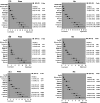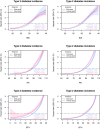Association between walking pace and incident type 2 diabetes by adiposity level: A prospective cohort study from the UK Biobank
- PMID: 36951683
- PMCID: PMC10947435
- DOI: 10.1111/dom.15053
Association between walking pace and incident type 2 diabetes by adiposity level: A prospective cohort study from the UK Biobank
Abstract
Aims: To investigate the combined association of adiposity and walking pace with incident type 2 diabetes.
Methods: We undertook a prospective cohort study in 194 304 White-European participants (mean age 56.5 years, 55.9% women). Participants' walking pace was self-reported as brisk, average or slow. Adiposity measures included body mass index (BMI), waist circumference (WC) and body fat percentage (BF%). Associations were investigated using Cox proportional hazard models, with a 2-year landmark analysis. A four-way decomposition analysis was used for mediation and additive interaction.
Results: The median (interquartile range) follow-up was 5.4 (4.8-6.3) years. During the follow-up period, 4564 participants developed type 2 diabetes. Compared to brisk-walking participants with normal BMI, those with obesity who walked briskly were at an approximately 10- to 12-fold higher risk of type 2 diabetes (hazard ratio [HR] 9.64, 95% confidence interval [CI] 7.24-12.84, in women; HR 11.91, 95% CI 8.80-16.12, in men), whereas those with obesity and walked slowly had an approximately 12- to 15-fold higher risk (HR 12.68, 95% CI 9.62-16.71, in women; HR 15.41, 95% CI 11.27-21.06, in men). There was evidence of an additive interaction between WC and BF% and walking pace among women, explaining 17.8% and 47.9% excess risk respectively. Obesity mediated the association in women and men, accounting for 60.1% and 44.9%, respectively.
Conclusions: Slow walking pace is a risk factor for type 2 diabetes independent of adiposity. Promoting brisk walking as well as weight management might be an effective type 2 diabetes prevention strategy given their synergistic effects.
Keywords: body fat; gait; mediation; obesity; type 2 diabetes mellitus.
© 2023 The Authors. Diabetes, Obesity and Metabolism published by John Wiley & Sons Ltd.
Conflict of interest statement
The authors declare no conflicts of interest.
Figures


Similar articles
-
Association of Self-reported Walking Pace With Type 2 Diabetes Incidence in the UK Biobank Prospective Cohort Study.Mayo Clin Proc. 2022 Sep;97(9):1631-1640. doi: 10.1016/j.mayocp.2022.02.028. Mayo Clin Proc. 2022. PMID: 36058577
-
Combined association of walking pace and grip strength with incident type 2 diabetes.Scand J Med Sci Sports. 2022 Sep;32(9):1356-1365. doi: 10.1111/sms.14197. Epub 2022 Jun 3. Scand J Med Sci Sports. 2022. PMID: 35612725 Free PMC article.
-
Walking pace and microvascular complications among individuals with type 2 diabetes: A cohort study from the UK Biobank.Scand J Med Sci Sports. 2024 Jan;34(1):e14501. doi: 10.1111/sms.14501. Epub 2023 Sep 23. Scand J Med Sci Sports. 2024. PMID: 37740713
-
Anthropometric and adiposity indicators and risk of type 2 diabetes: systematic review and dose-response meta-analysis of cohort studies.BMJ. 2022 Jan 18;376:e067516. doi: 10.1136/bmj-2021-067516. BMJ. 2022. PMID: 35042741 Free PMC article.
-
Mediation effects of diabetes and inflammation on the relationship of obesity to cognitive impairment in African Americans.J Am Geriatr Soc. 2022 Oct;70(10):3021-3029. doi: 10.1111/jgs.17985. Epub 2022 Aug 8. J Am Geriatr Soc. 2022. PMID: 35941823 Free PMC article. Review.
Cited by
-
Usual walking Pace and risk of 28 cancers- results from the UK biobank.BMC Cancer. 2025 May 14;25(1):869. doi: 10.1186/s12885-025-14258-x. BMC Cancer. 2025. PMID: 40369483 Free PMC article.
References
-
- International diabetes federation . IDF Diabetes atlas ninth edition. 2019. www.diabetesatlas.org
-
- Saeedi P, Petersohn I, Salpea P, et al. Global and regional diabetes prevalence estimates for 2019 and projections for 2030 and 2045: results from the international diabetes federation diabetes atlas, 9(th) edition. Diabetes Res Clin Pract. 2019;157:107843. - PubMed
-
- Piché M‐E, Tchernof A, Després J‐P. Obesity phenotypes, diabetes, and cardiovascular diseases. Circ Res. 2020;126(11):1477‐1500. - PubMed
-
- Verma S, Hussain ME. Obesity and diabetes: an update. Diabetes Metab Syndr. 2017;11(1):73‐79. - PubMed

